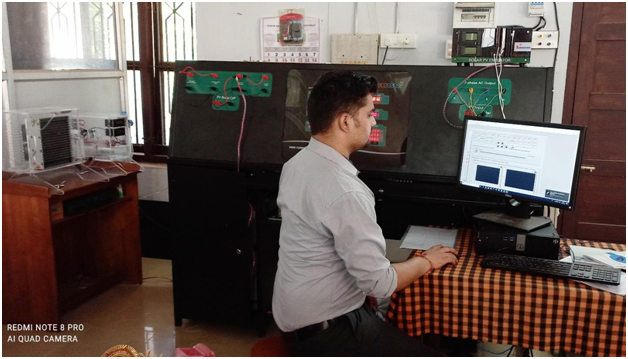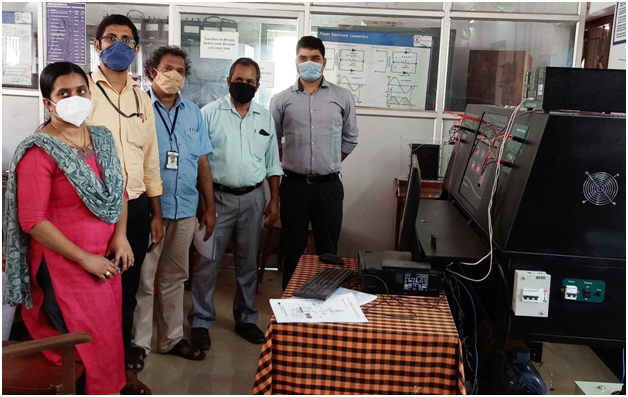Microgrid Lab is installed at Department of Electrical Engineering, GCE, Kannur.
What is a Microgrid?
A Microgrid is a localized group of electricity sources and sinks (loads) that typically operates connected to and synchronous with the traditional centralized grid (macro-grid), but can also disconnect and maintain operation autonomously or go completely off-grid as per the requirement.
How does a Microgrid work?
To understand how a Microgrid works, you first have to understand how the grid works.
The grid connects homes, businesses and other buildings to central power sources, which allow us to use appliances, heating/cooling systems and electronics. But this interconnectedness means that when part of the grid needs to be repaired, everyone is affected.
This is where a Microgrid can help. A Microgrid generally operates while connected to the grid, but importantly, it can break off and operate on its own using local energy generation in times of crisis like storms or power outages, or for other reasons.
A Microgrid can be powered by distributed generators, batteries, and/or renewable resources like solar panels. Depending on how it’s fueled and how its requirements are managed, a Microgrid might run indefinitely.
Ecosense’s Microgrid system
Ecosense’s Microgrid system is an experimental and research system. It relies on three of the popular Renewable Energy sources i.e.; Solar PV, Wind and Fuel Cell.
Instead of Actual wind turbine we are using Wind Turbine Emulator. Wind turbine emulator mimics the behavior of wind turbine for hardware level simulations. This system has a DC motor coupled with the Permanent Magnet Synchronous Generator, speed of which is controlled as per the speed reference calculated by solving the mathematical model of wind turbine. Researcher can execute the mathematical models of their newly developed or modified wind turbine and can simulate the speed/power of profile of turbine on hardware environment directly for different wind speeds & pitch angle.
Similarly, instead of using Solar Panels we used Solar PV Emulator. Solar PV Emulator mimics the behavior of Solar PV Panels for hardware level simulations. This system comprises of two DC Switch Mode Power supplies which can be programmed by user to either behave like a solar panel or a DC Power supply. User can select and program solar panels in the range of 10 Wp - 1000 Wp per channel and configure them to work in Independent or Parallel configurations to actualize a Solar PV Array. By virtue of its features, it can be easily considered as a versatile Solar PV Array.
A 1 kW dry hydrogen-based fuel cell is also used as one of the sources in the hybrid system.
WTE-PVE- Fuel Cell Hybrid with DC Microgrid system combines the outputs of Wind Turbine emulator, PV Emulator and Fuel Cell at a common DC link which is further connected to a three-legged programmable inverter to deliver the combined power to an Actual Grid.

Ecosense’s Engineer testing Microgrid system at GCE,Kannur
Advantages of Ecosense’s Microgrid system
Ecosense’s Microgrid system enables user to do research in the field of Microgrid management, load side management, priority allocation to renewable sources etc. Ecosense’s Microgrid is an open-source system where a user can reprogram, rewire and revise the system to carry out their research goals. All the sources are independent of each other and research can also be carried out on each of the sources independently. Ecosense provides source file based on LabVIEW platform which can be easily modified as per the user’s liking. Ecosense appreciates and also provide an active support to users carrying out their research.
What’s New?
This time at GCE, Kannur Ecosense’s Wind Turbine Emulator uses a Permanent Magnet Synchronous Generator instead of Induction Generator. In the permanent magnet machine, the efficiency is higher than in the induction machine.

Group photo after Masters Training at GCE, Kannur
Masters Training Conducted
After installation a 2- day master’s training is conducted. This Masters training program was focused on educating and training the professors and scholars and technicians in Microgrid Technology who will further train thousands of students and professionals to start their career or business in this very field.
